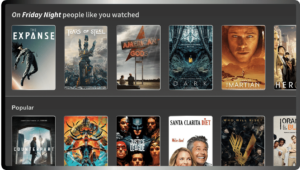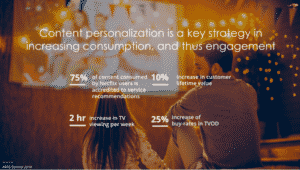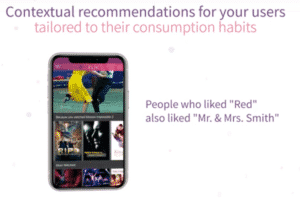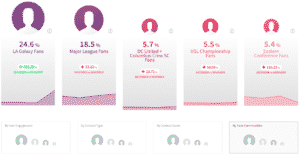Let’s talk about how personalization, it’ s a powerful tool to retain users of your OTT service. We are all attracted to things that, in some way, we feel are tailor-made for us individually. That’s why many brands from all industries are investing large resources to super-personalize their marketplace offerings for each type of client, to create that sense of identification with their products or services and thereby increase brand loyalty. In the entertainment industry, the personalization of user experience is just as important. In fact, the ability for a user to find the content they want to see in the exact moment they want to see it is one of the primary means to ensure they stay on for longer. Who doesn’t know what it’s like to arrive home after a tiring workday, wanting to disconnect and watch their favorite series? But if the recommendations that popped up at that time were for children’s programming or some content unrelated to our interests, chances are we’d feel pretty irritated with the service.
This is why understanding your audience and the ability to provide them with the content they want at any given moment is –or at least, should be– a major premise of any OTT service.
The success of any OTT platform depends on content, discovery, user interface, and user experience, among other factors. User behaviour analysis and AI/ML-based personalized recommendations play a significant role here. Personalization works on all these factors and simultaneously helps OTT brands address marketing challenges related to reducing the costs of customer acquisition and conversion rates, offering Individualized recommendations of relevant content and increasing average user content consumption and thus increasing engagement and CLTV.
Any video service that wants to succeed must deliver the right content to the right users at the right time in the right place.
Knowing your customer’s journey lets you display individualized and personalized experience across all digital platforms.
How does AI/ML-driven personalization work?
AI and ML have evolved a lot in the last years and nowadays can learn from almost anything, even from human behavior. ML algorithms can analyze large sets of data to identify behavioral affinities, create relevant insights to predict future actions based on past behavior and analyze individual users’ tastes and consumption habits.
Using these technologies, a marketer can expect to deliver 25-50% higher conversion rates by personalizing the entire customer journey.
How does one personalize user experience?
- By offering contextual recommendations for your users tailored to their consumption habits: providing personalized recommendations adapted to different user consumption scenarios to increase user satisfaction and engagement.
-
- Recommendations by user similarity and product similarity: provide different recommendations to your users based on similar products and products consumed by similar users.
- Recommendations by time of day: Make user recommendations for morning, evening, nighttime, 3pm or 12am, etc.
- Recommendations by device: Give your users recommendations for their smartphone, web browser, game console or Smart TV, etc.
- Recommendations by day of the week: Make different recommendations to your viewers for a Monday workday than for a Friday weekend, etc.

- Offer an ultra-personalized experience by configuring individualized digital content: enhance your digital service personalization, easily fine-tuning the recommendation engine according to your personalization strategy.
- Weighted personalization by product category: configure your recommendations to prioritize a specific product category when recommending content to your user
- Personalized curated content: showcase new products, seasonal products or campaign-related products as selected by your curators
- Product blacklists: hide the products that your curators flag as unsuitable for particular user groups
Recommendation grid configuration: configure your recommendation ribbon messaging and formatting for various recommended content items.
- Recommendation performance tracking through performance analysis of recommended products: assess your digital service recommendation performance and fine-tune the recommendation strategy and configuration through repeated iterations.
- Recommendation impressions: “How many people did my recommendations reach?”
- Recommendation impressions CTR: “What percentage of people showed interest in my recommendations?”
- Recommendation conversion rate: “How many people consumed the content I recommended?”

- Personalized Marketing Campaigns: sending personalized emails or push notifications, for example, rides on the philosophy of personalizing the entire customer journey. Hyper-segment your audience and send each one different messages through the most effective channels.
- Personalized Push Notifications: this is a good way to deliver highly personalized communications, promotions and contextual recommendations to users at the right time. Push notifications capture user attention immediately, so it is important to make sure they are properly timed and are only sent to the user when they are most likely to view your content or do a specific action.
Why should you use AI/ML data-driven personalization for your video service?
- It greatly helps you reduce structural costs. We know how expensive and difficult it can be to create a data science team, but you don’t need to have one in-house with tools like Jump Personalizer that help you obtain the best insights to know your users’ behaviour and effectively use that data powered by ML to offer them individualized content recommendations and a personalized user experience on your platform.
- It saves you time and lets you automate the personalization process. ML algorithms work in a very dynamic way; we set up the system for you and once it’s in place, it learns from your users’ behavior, to clusterize users and makes personalized recommendations on its own.
- It’s very scalable, although the more information, the better. ML algorithms learn by themselves, so the more data they analyze, the better, because it lets them improve and become more efficient when they are suitable for the scenarios where you want to personalize a large amount of content.
Would you like to know how to begin creating personalized recommendations for your media service? Let’s chat!



